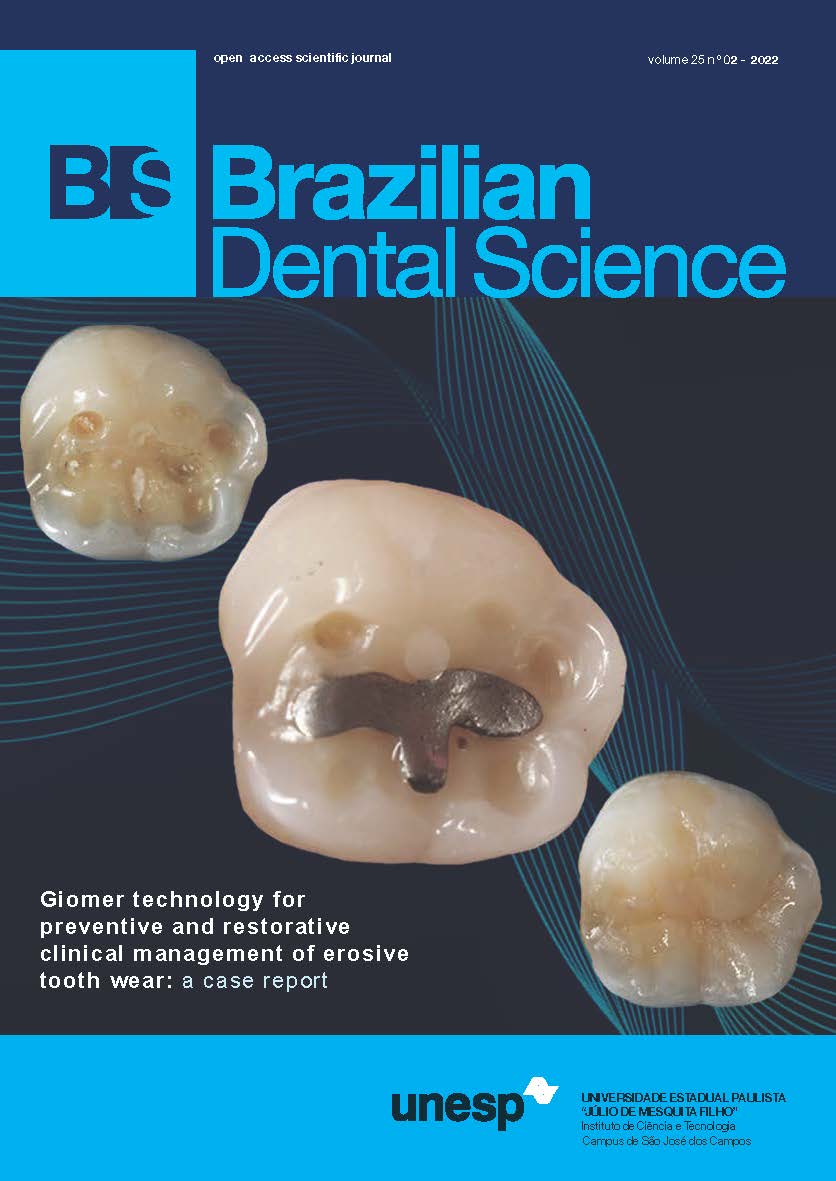Influence of diode laser and warm air drying on the shear bond strength of Lithium di-silicate to Dentin. An in-vitro study
DOI:
https://doi.org/10.4322/bds.2022.e2782Resumo
Objective: The current study aimed to evaluate the effect of diode laser irradiation (980 nm) and warm air drying
(50°C) on shear bond strength between Lithium di-silicate (IPS e.max; Ivoclar) and human dentin using both
(Etch & Rinse) adhesive, Adper™ Single Bond 2 (3M ESPE) and (Self-etch) adhesive, Single Bond UniversalTM
(3M ESPE) before adhesive polymerization. Material and Methods: 54 sound lower molars were sectioned to
obtain flat dentinal surfaces. Specimens were divided into 2 equal groups (n=27): Group 1 (ER) and Group 2
(SE) according to bonding approach. Each subgroup was subdivided according to dentin surface treatment into
3 equal subgroups (n=9): Control (Co), Diode laser irradiation (L) and Warm air drying (W). All specimens
were adhesively cemented to IPS e.max® CAD discs using RelyX™ Ultimate Clicker™(3M ESPE) resin cement.
Samples were then subjected to pre-loading in a thermodynamic manner. All samples were tested for shear
bond strength using computer-controlled material testing machine. Data analysis was performed using two-way
(ANOVA) (p< 0.05) followed by pair-wise Tukey’s post-hoc tests. Results: In (SE) group, the subgroup (W) had
the highest shear bond strength values followed by (Co) subgroup and the least was (L) subgroup with statistically
significant difference. As for (ER) group, the subgroup (W) had the highest shear bond strength values followed
by (Co) subgroup and the least was (L) subgroup with no statistically significant difference. Conclusion: Warm
air drying for (SE) bonding approach increased shear bond strength of Lithium di-silicate to human dentin and
can be introduced as a new effective protocol.
KEYWORDS
Adhesives; Diode laser; IPS e.max; Shear bond strength; Warm air drying.
Downloads
Downloads
Publicado
Como Citar
Edição
Seção
Licença
TRANSFERÊNCIA DE DIREITOS AUTORAIS E DECLARAÇÃO DE RESPONSABILIDADE
Toda a propriedade de direitos autorais do artigo "____________________________________________________________________" é transferido do autor(es) para a CIÊNCIA ODONTOLÓGICA BRASILEIRA, no caso do trabalho ser publicado. O artigo não foi publicado em outro lugar e não foi submetido simultaneamente para publicação em outra revista.
Vimos por meio deste, atestar que trabalho é original e não apresenta dados manipulados, fraude ou plágio. Fizemos contribuição científica significativa para o estudo e estamos cientes dos dados apresentados e de acordo com a versão final do artigo. Assumimos total responsabilidade pelos aspectos éticos do estudo.
Este texto deve ser impresso e assinado por todos os autores. A versão digitalizada deverá ser apresentada como arquivo suplementar durante o processo de submissão.




























